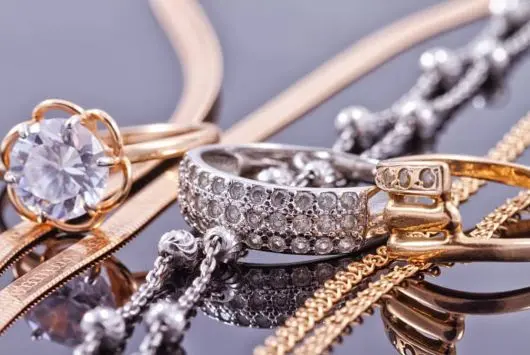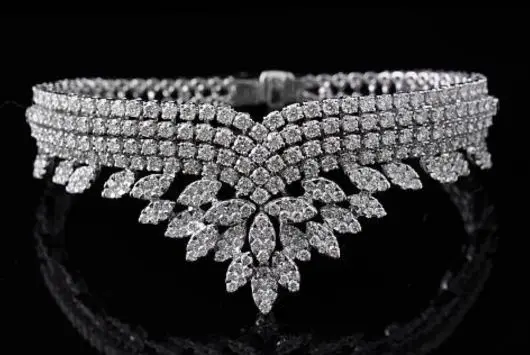PLATINUM & WHITE GOLD JEWELRY
Platinum and white gold Jewelry specifications highlight the characteristics that define the quality, appearance, and value of these metals when used in jewelry. Below are the detailed specifications for platinum and white gold jewelry:


1. Platinum Jewelry Specifications
1.1. Purity
Platinum Purity: Platinum used in jewelry is typically 85%-95% pure. The most common standard is 950 platinum, meaning 95% of the metal is pure platinum, and the remaining 5% is made up of other metals like iridium or ruthenium for strength.
Higher Purity: Some platinum jewelry may be made from 990 platinum (99% pure), though this is rarer due to its softness.
1.2. Weight and Durability
Density: Platinum is denser and heavier than gold, making platinum jewelry more substantial. It is ideal for pieces that require strength, such as engagement rings and wedding bands.
Durability: Platinum is highly durable and resistant to tarnish, corrosion, and rust. Unlike other metals, it does not oxidize or lose its color over time.
1.3. Color
Natural Color: Platinum has a naturally white, silvery appearance, making it perfect for showcasing diamonds and other gemstones. It maintains its shine and does not require rhodium plating, unlike white gold.
High Luster: Platinum jewelry has a bright, shiny finish that enhances the sparkle of diamonds and gemstones.
1.4. Hypoallergenic
Allergic Reactions: Platinum is hypoallergenic, making it an excellent choice for people with sensitive skin or metal allergies. It contains very few alloys, which reduces the risk of reactions.
1.5. Scratch Resistance
Hardness: Platinum is highly resistant to scratching, though it can show signs of wear over time, such as the metal developing a patina, especially on rings and bracelets. This can be polished back to its original shine.
1.6. Maintenance
Care: While platinum is low maintenance, it may develop a patina over time, which some people appreciate for its classic look. However, it can be polished back to its original shine by jewelers.
1.7. Cost
Pricing: Platinum is more expensive than white gold due to its rarity, higher purity, and heavier weight. The cost may also vary based on the design and craftsmanship of the jewelry.
2. White Gold Jewelry Specifications
2.1. Purity
Gold Purity: White gold is made from gold mixed with other white metals like palladium, silver, nickel, or platinum. The purity of white gold is expressed in karats (K):
18K White Gold: Contains 75% gold and 25% other metals.
14K White Gold: Contains 58.3% gold and 41.7% other metals.
10K White Gold: Contains 41.7% gold and 58.3% other metals.
Karat Scale: Higher karat white gold jewelry (18K and 22K) contains more gold, making it softer and more prone to scratching than 14K or 10K.
2.2. Rhodium Plating
Rhodium Coating: White gold jewelry is typically plated with rhodium, a platinum-group metal, to give it a bright, white, and shiny finish. This plating also enhances the jewelry’s resistance to tarnishing and adds extra durability.
Re-plating: Over time, the rhodium plating can wear off, especially on rings and bracelets, requiring periodic re-plating to restore the bright white appearance.
2.3. Color
Natural vs. Plated: White gold has a slightly yellowish tint when unplated due to the gold content. The rhodium plating gives it the desired white color, resembling platinum or silver.
Variety of Tones: White gold can appear in different shades, depending on the alloys used. For instance, 18K white gold may appear more yellowish, while 14K white gold is generally a lighter shade.
2.4. Hypoallergenic Properties
Nickel Content: Some white gold alloys contain nickel, which can cause allergic reactions in people with sensitivities. For hypoallergenic white gold, look for alloys that use palladium or platinum instead of nickel.
Nickel-Free Options: Many jewelers offer nickel-free white gold alloys for people with sensitive skin.
2.5. Durability
Strength: White gold is less dense than platinum, making it less durable, though still strong and suitable for daily wear.
Scratch Resistance: White gold can scratch more easily than platinum due to its softer composition. Regular maintenance like rhodium re-plating helps restore its appearance.
Alloy Durability: Depending on the alloy mix, white gold may be more prone to tarnishing compared to platinum, especially if not properly maintained.
2.6. Cost
Pricing: White gold is typically more affordable than platinum due to its lower material cost and use of other metals in the alloy. The cost also varies with the karat and rhodium plating quality.
3. Common Jewelry Designs in Platinum and White Gold
3.1. Rings
Engagement Rings: Both platinum and white gold are popular choices for engagement rings, with platinum often favored for its durability and hypoallergenic properties, while white gold offers a more affordable option.
Wedding Bands: These metals are commonly used for wedding bands, with platinum being more expensive but long-lasting, while white gold offers a shiny and elegant appearance.
3.2. Necklaces and Pendants
Necklaces: Both platinum and white gold necklaces offer a sophisticated look, with platinum providing a heavier and more luxurious feel.
Pendants: A variety of pendants, often set with diamonds or gemstones, can be crafted in either platinum or white gold.
3.3. Earrings
Studs, Hoops, and Drops: Platinum and white gold are both used to make elegant earrings, with platinum often used in higher-end, long-lasting designs and white gold offering more affordable elegance.
3.4. Bracelets
Tennis Bracelets: Both metals are used to create beautiful tennis bracelets, with platinum offering durability and a premium look, while white gold offers a similar appearance at a lower cost.
4. Maintenance and Care
Platinum Care: Platinum jewelry may develop a patina over time but doesn’t require re-plating. It can be polished to restore its original shine.
White Gold Care: White gold requires periodic rhodium re-plating to maintain its white color and prevent tarnishing. Cleaning with a soft cloth and avoiding harsh chemicals is recommended to preserve the rhodium finish.
